Abstract
Ultra-high-temperature and pressure downhole environments pose challenges for conventional electronic instruments to adapt to high-temperature formations, thereby restricting the application of downhole electronic tool technology in deep and ultra-deep wells. Given the aforementioned limitation of electronic inclination measurement systems, specifically their poor temperature resistance, this study proposes a novel shunt flow control method. This method employs a mechanical structure to overcome temperature constraints: gravitational torque generated by the mechanical structure is utilized to control valve opening and regulate flow rate. By converting sensed well inclination information into changes in flow rate, this approach enables the transformation of well inclination sensing and its associated signals. In this study, a kinetic analysis model of the shunt-regulating valve spool was established. Using computational fluid dynamics (CFD) simulations, the flow characteristics of the regulating spool were analyzed under varying valve openings. The structure of the flow control valve was optimized with the goal of maximizing internal flow. Finally, the reliability of the designed structure for well deviation sensing and flow control was verified using simulation experimental studies and theoretical analyses.
1. Introduction
As a common physical model, pendulums have a wide range of applications in various fields. The use of single-pendulum structures to accomplish tool measurements and as actuating structures in the petroleum engineering field is more obvious, and the use of mechanical structures can be better adapted to complex and harsh downhole conditions [1,2]. For instance, rotationally guided stabilizers, eccentric stabilizers in mechanical vertical drilling systems, and well-deviation-sensing elements in mechanical inclinometers all utilize the motion characteristics of pendulums to meet their respective functional requirements [3,4].
Photographic tilt measurement technology is based on the principles of gravity and imaging. Specifically, it utilizes the projected imaging of a freely vertical plumb bob on a tilted concentric dial and determines the well deviation angle according to the distance from the imaging position to the center. Mechanical wireless inclinometers leverage the principle that objects under gravity naturally stay vertical. They form an inclination measurement structure with a pendulum, a step ring, and a control axis. Under gravity, the pendulum remains freely vertical. When the pendulum moves upward from the bottom along with the control axis, it inevitably hangs on a specific step of the step ring due to the latter’s inclination. When the inclination angle of the step ring is different, the pendulum will hang on different steps. In this way, the inclination angle of the step ring can be determined from the position of the steps on which the pendulum hangs, thus determining the inclination of the measured borehole [5].
Mechanical automatic vertical drilling tools are mainly composed of three key components: a gravity-sensing mechanism, a disk valve control mechanism, and a push-against actuator. Among them, the gravity-sensing mechanism is the control and execution part of the tool, which is the key part of the mechanical automatic vertical drilling tool. The gravity-sensing mechanism employs an eccentric structure, which stabilizes at the lower side of the borehole under gravity. Concurrently, the fluid flow channel driving the upper disk valve stabilizes at the opposite higher side. This configuration ensures that the push-against actuator consistently extends at the borehole’s high side, achieving automatic borehole deskewing. The system utilizes the pressure difference between the inner and outer drilling fluid to generate driving force, with a structure designed for simplicity and reliability [6,7,8,9,10].
The dynamic push-to-recline rotary-guiding tool is used to adjust the drilling direction of the bit. In designing the structure of its control system, the basic theories and research results of mechanical automatic vertical drilling tools are drawn upon. A middle disk valve with a gravity-stabilized mechanical structure is specifically designed, which serves to eliminate the impact of the lower disk valve’s rotation on the surface of the upper disk valve [11].
The anti-skewing eccentric drill tool combination leverages the centrifugal force generated by the eccentric drill tool during rotation and the supporting effect of the eccentric band on the short eccentric drill collar. This configuration reduces the inclination of the drill bit axis, increases the downward force, and exhibits high anti-skewing performance [12]. The eccentric drill collar is fabricated by turning eccentric joints at both ends of a conventional drill collar. Its advantage lies in it not reducing the bending stiffness of the drill collar, while its disadvantage is its difficulty in processing. Eccentric drill collars are an effective anti-slope drilling tool which have achieved good results in drilling in sloping formations in Daqing, Jianghan, and Lenghu oilfields [13,14]. The eccentric shaft anti-slope drilling tool is an eccentric joint placed in the bottom drilling tool assembly, causing the geometric center of the drilling tool at the bottom of the well and the center of gravity to not coincide. The axes of the drilling tools below the eccentric joint exhibit a certain eccentricity relative to the upper part of the joint. Torque is transmitted from the top to the bottom, generating a large centrifugal force. This force induces the drill string to perform a stable bowed rotational motion inside the borehole, causing the drill to cut evenly around the well wall. Consequently, the assembly achieves anti-slope and deskewing effects [15,16]. In addition, for example, the pendulum drilling tool anti-slope technology directly utilizes the principle of a single pendulum, which generates pendulum force through eccentric force, counteracting formation force and preventing the well from sloping [17,18,19].
Current technologies primarily focus on sensing and indicating inclination angles (e.g., wireless inclinometers) or on converting inclination information into mechanical actuation for wellbore correction (e.g., automatic vertical drilling tools and anti-deviation bottomhole assemblies). However, a critical gap remains in the dynamic regulation of downhole fluid flow based on real-time inclination feedback. This capability is essential for scenarios such as directional drilling fluid distribution, downhole tool triggering, or parameter adjustment in extreme downhole conditions.
Existing flow control methods either rely on electronic sensors and actuators (which are prone to failure under ultra-high-temperature and high-pressure environments (HTHP environments: >200 °C, >150 MPa) or lack purely mechanical solutions that integrate inclination sensing with flow regulation. This disconnect limits the ability to adaptively regulate flow based on wellbore inclination in deep wells and harsh well conditions, thereby hindering the integration of functions like inclination sensing and flow control.
To address this limitation, this paper designs a mechanical downhole flow control regulator valve. Using a mechanical eccentric structure, the valve senses changes in well inclination and further controls flow rate variations, thereby meeting the flow control requirements for special downhole environments. It is adapted to ultra-high-temperature and high-pressure conditions. The overall structure of the designed mechanical offset flow control valve is designed to include the main parameters; the valve port is optimized, and the flow characteristics of the flow diversion process are analyzed.
2. Key Structural Design and Analytical Modeling
2.1. Composition of Gravity-Driven Flow Control Valve
The gravity-driven flow control valve designed in this paper mainly consists of two parts: the regulating valve and the brake mechanism. The regulating valve is the key component for realizing shunt regulation. It can sense the direction of gravity, and its valve opening is controlled by the deflection torque of the spool itself. This mechanism converts the valve body’s tilt angle into a flow signal. With the use of circumferential throttling valve port, the valve body opened on the sealing column surface assembled with a rotating spool, with the rotating axis perpendicular to the axis of the valve body.
A throttling groove is machined in the valve body. The overlap between the spool’s valve port and the opening of the throttling groove forms a throttling valve port. A portion of the drilling fluid enters an internal flow path (pre-set in the valve body) through this throttling valve port, while another portion overflows into an external flow path, as shown in Figure 1. The eccentric block adopts a hinged structure, ensuring the spool always aligns with the direction of gravity. When the tilt angle of the valve body changes, the relative angle between the spool and the valve body varies, thereby altering the blocking area of the valve port and throttling groove.

Figure 1.
Working principle of gravity-driven flow control valve: (a) structure of gravity-driven flow control valve; (b) valve spool movement process.
The brake mechanism serves to lock the position of the eccentric component, preventing mechanical vibrations and fluid impacts during drilling. This ensures the stable operation of the regulating valve, and its structure is illustrated in Figure 2a. The brake disk is fixedly connected with the eccentric part. When the mud pump starts operating, the push rod moves downward under the dynamic pressure of the mud. This drives the link rod to press the friction plate against the brake disk, generating a braking force. The link rod can only translate along the guiding groove. When it reaches the locked state shown in Figure 2b, the eccentric part and the brake plate will remain in their original positions. When the circulation of the drilling fluid ceases, the spring force will drive the push rod outward, thereby releasing the locked state of the regulating valve. Subsequently, the eccentric component will re-sense the tilt angle and initiate the next working cycle. The mechanical inclinometer is a typical application scenario of the above structure. The flow field inside the valve body is redistributed, and the magnitude of the distributed flow rate is correlated with the valve body’s tilt angle. This enables infinite, continuous, and high-precision well inclination measurements.
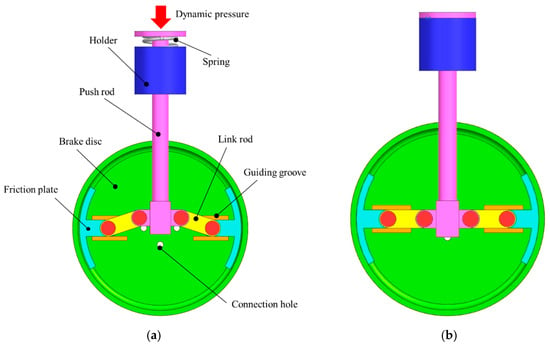
Figure 2.
Working process of brake mechanism: (a) structure diagram; (b) mechanism locking status.
According to the law followed by the parallel connection of pipelines, the total flow rate of the parallel flow path pipeline is equal to the sum of the manifolds. The relationship between the flow rate of the two manifolds and the total flow path in the parallel pipeline is expressed as Q = Q1 + Q2. According to the throttling principle of the regulating valve, the equation for the liquid flow through the regulating valve can be derived as
In the equation, Ar is the minimum flow area between valve spool and valve body, ζ is the resistance coefficient, and Δpr is the pressure loss. The equation indicates that the upper and lower orifice overlap area of the regulating valve is changed to be able to regulate the flow rate of the inner flow path.
2.2. Numerical Simulation Methods
The fluid movement process inside the regulating valve can be analyzed based on the fundamental principles of energy conservation, the laws of momentum, and mass conservation. Its internal flow can be considered a three-dimensional steady-state non-pressure flow [20,21,22]. Therefore, Navier–Stokes (N-S) equations can be used to describe its internal flow, and the standard k-turbulence model can be used to close the momentum equation:
In the equation, xi and xj are the coordinate components, ui and uj are the velocity components, v is the kinematic viscosity, vt is the vortex viscosity coefficient, ρ is the liquid density, and P is the pressure. The equation for turbulent pulsation kinetic energy k adopted herein is as follows:
In order to analyze the shunt effect of the flow control valve, the simulation model shown in Figure 3b was established. The model includes the valve front flow channel, the baffle, the throttle valve port and flow channel between the weight block and the valve body, and the inner flow channel in the valve body. The internal flow path was extracted as the computational domain for numerical simulation. To ensure simulation accuracy, the flow path upstream of the valve was extended to twice its original length. Additionally, both internal and external flow paths were extended to six times the flow diameter to enable full fluid development. In order to take into account the amount of calculation necessary and the accuracy of the solution, an unstructured tetrahedral mesh was used for global meshing, the throttle groove and valve spool were encrypted, and the boundary layer was set for the internal flow path. The growth rate was set to 1.2, and the maximum number of layers was set to 5. In this paper, internal flow monitoring is carried out under the working conditions of an inlet flow rate of 30 L/s and a spool angle of 15°, and the change curve of the valve port flow with the number of grids is obtained. According to the grid independence test, when the number of grids reaches a certain range, the internal flow rate remains basically stable. Therefore, as shown in Figure 4, in order to save computational costs, the final number of fluid grids inside the valve was determined to be 1,163,270, and the number of nodes was 228,889. The meshing of the fluid domain is shown in Figure 3a.
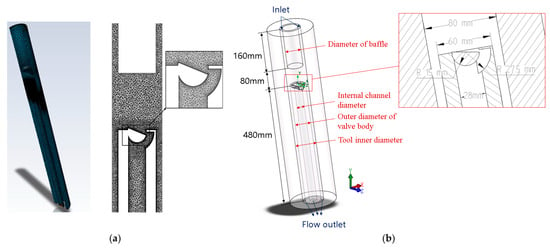
Figure 3.
Three-dimensional simulation model and dimensions: (a) model mesh; (b) simulation model.
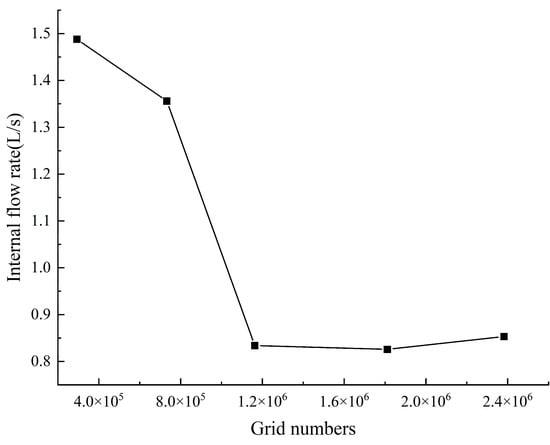
Figure 4.
Mesh agnostic validation.
Velocity inlet is used for the inlet and free outflow for the outlet. The internal wall meets the no-slip condition, so the standard wall function is utilized for the near-wall region. An unstructured mesh is used to divide the flow channel. Mesh quality is enhanced through mesh optimization and smoothing. The pressure and velocity fields are solved using a semi-implicit method based on the finite volume method, which incorporates a pressure-coupled system of equations. During the numerical iterative operations, subrelaxation techniques are utilized to accelerate the computational convergence [23,24,25,26]. The key structural parameters of the model are shown in Table 1.

Table 1.
Key structural parameters.
Set the valve body tilt angle between 0 and 20° and divide it into 20 sets of different angles for analysis based on the size of the valve body tilt angle. The fluid medium is liquid water, the analysis type is internal flow excluding a non-flowable cavity, and the flow type is turbulent. The velocity flow inlet is located at the top of the flow path in front of the baffle and is set at 30 L/s, and the pressure flow outlet is set at the inner and outer flow paths [27,28,29,30,31]. Set the adjusted total inlet flow rate to 20–30 L/s, which conforms to the conventional drilling fluid flow range in the drilling process.
3. Results and Discussion
3.1. Valve Port Shunt Characterization
The flow characteristic curve with an inlet flow rate of 30 L/s is shown in Figure 5. From the figure, it can be found that, with an increase in the valve body tilt angle, the valve opening gradually increased, and the flow of the inner flow path also corresponds to the valve opening of the change rule to maintain consistency with the trend of approximate linear increase. When the valve body tilt angle is 0°, due to the throttle valve port being closed, the flow of the inner flow path of the smallest port is 0. When the throttle valve port increased to a maximum of 20° regarding the valve body tilt angle state, the distribution of the flow to the inner flow path reached a maximum of 1.04 L/s. As the incoming input flow rate was the same, according to the pipeline parallel flow law, the flow of the distribution of the flow path of the external channel shows a linear decreasing trend.
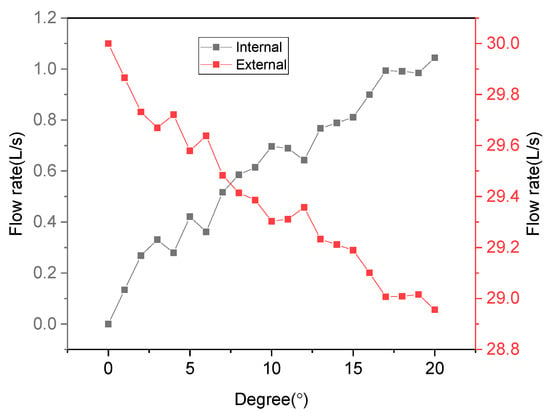
Figure 5.
Flow characteristics under different valve body inclination angles.
Fluid viscosity is an important factor affecting flow law, and the flow characteristics of valves vary under different viscosities. Temperature can change the viscosity of fluids. Therefore, it is necessary to study the influence of viscosity on the diversion characteristics and simulate the diversion valve by changing the fluid viscosity from 0.001 to 0.1. Figure 6 shows the flow rate through the flow control valve at different fluid viscosities. The viscosity has a significant impact on the flow characteristics. As the viscosity increases, the internal flow rate increases from 0.83 L/s to 1.63 L/s. When the viscosity is higher than 0.05, there is a linear relationship between flow rate and viscosity, and the change in flow rate is very small. When the viscosity is below 0.05, viscosity has a greater impact on flow characteristics. This is because the higher the viscosity, the greater the flow friction resistance. The external flow channel has more solid wall, which makes its flow friction resistance increase faster with viscosity than the internal flow channel. Based on the pipeline parallel flow law, more fluid enters the internal flow channel.
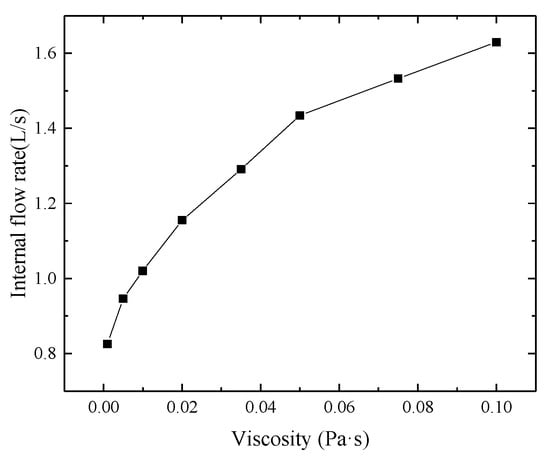
Figure 6.
Flow characteristics under different fluid viscosities.
3.2. Valve Flow Characterization
Figure 6 and Figure 7 shows a full sectional view of the regulating valve, which includes the following components: a baffle, a valve body, a shunt interval between the baffle and the regulating valve, a throttle groove in the valve body, a rotary valve spool, and a throttle port at the inlet of the throttle groove (the opening of which is adjusted by the spool). Based on the analysis of the flow characteristics of the regulating valve, geometric parameters, such as the throttle groove diameter, inlet length, and valve body outer diameter, were selected as research objects, designated H1–H5. The related parameters are shown in Table 2.
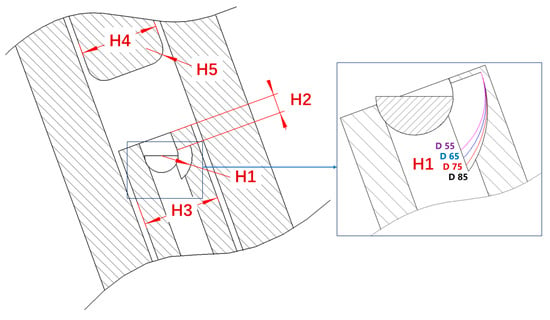
Figure 7.
Structural parameters of gravity-driven flow control valve.

Table 2.
Different values for gravity-driven flow control valve geometric parameters.
To investigate how regulating valves affect flow characteristics under different geometric parameters, the inlet pressure and flow rate of the valve were monitored across various combinations of these parameters.
Table 3 presents the response combinations of different geometric parameters of the valve body, derived from the analysis of orthogonal test results. Each row in the table represents a scenario with a specific combination of geometric parameter levels. The numbers 1–4 in the table indicate the different levels corresponding to the geometric parameter factors in their respective columns. The specific values of the geometric parameters at these corresponding factor levels can be found in Table 2 [32,33].

Table 3.
Orthogonal experimental design and results.
The data in Table 3 were analyzed and processed using the range analysis method. After processing, the range values (R) of the five factors were calculated and ranked so as to determine the importance of different geometric parameters in influencing the flow rate of the internal flow channel.
The main effect plots of different geometrical structure parameters, with maximum inward flow channel flow rate as the optimization objective, are shown in Figure 8, which enables a more intuitive comparison of the average factor size. From the figure, it can be observed that to achieve a higher internal flow rate at the same spool opening, the following adjustments are required: increase Factor 3 to reduce the flow area of the external channel; increase the size of Factor 1; reduce Factor 4 to expand the flow area of the channel in front of the valve; and increase the diameter of Factor. Factor 2 has a relatively small impact on the flow rate.
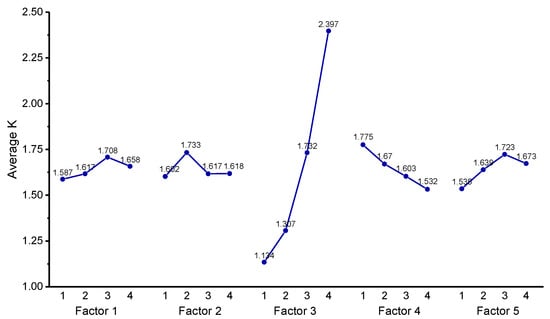
Figure 8.
Schematic diagram of the main relationship between geometric parameters and internal flow rate.
The geometric parameter combination for the optimal scheme is as follows: Factor 1 at Level 3, Factor 2 at Level 2, Factor 3 at Level 4, Factor 4 at Level 1, and Factor 5 at Level 3. The worst combination is as follows: Factor 1 at Level 1, Factor 2 at Level 1, Factor 3 at Level 1, Factor 4 at Level 4, and Factor 5 at Level 1. To further investigate how geometric parameters affect the maximum flow rate in the internal flow channel, 3D geometric models of the two schemes were established for numerical simulations. The flow characteristics of these two models were then compared and analyzed. Table 4 presents a comparison of numerical simulation results for the internal flow channel flow rates between the optimal and worst geometric parameter schemes. Under the conditions of an inlet flow rate of 30 L/s and an outlet pressure of 0.1 MPa, the internal flow channel flow rate of the optimal scheme is 2.59 L/s, which is 6.94 times that of the worst scheme.

Table 4.
Comparison of the numerical calculation results for the geometric parameter schemes based on internal flow rate.
The comparison of geometric parameter schemes for the maximum flow rate of the internal channel is shown in Figure 9. By comparing the pressure contour maps, it was found that the optimal design scheme features a larger outer diameter of the valve body. This reduces the flow area of the external flow channel, increases fluid resistance, and elevates the upstream pressure. The pressure difference before and after the regulating valve in the optimal design scheme is much higher than that in the worst design scheme. In addition, compared to the worst design scheme, the optimal one features a larger filet curvature at the outlet of the flow channel in front of the valve. This suppresses the size of the vortices generated in the cavity and reduces the flow energy loss. Similarly, the optimal scheme has a larger throttle groove diameter than the worst. This increases the valve’s equivalent flow surface area and helps boost the flow rate in the internal channel.

Figure 9.
Simulation results of geometric parameter scheme, with the aim of maximizing internal flow rate: (a) pressure contour; (b) velocity contour.
After discussing the effect of geometrical construction parameters on the maximum flow rate in the flow path within a regulating valve, its effect on the valve flow coefficient is discussed. The flow coefficient of a control valve is an important index used to measure its flow capacity and is often expressed by C, which is related to the spool and valve structure of the regulating valve, the nature of the fluid, and the pressure difference before and after the regulating valve. The flow coefficient of the valve can be expressed as
In the equation, qV refers to the fluid flow through the regulating valve, γ refers to the density of the fluid medium, and Δp refers to the pressure loss generated by the regulating valve. In the simulation study in this section, the inlet flow rate is the same and the outlet pressure is the same for all models. Therefore, the change in inlet pressure reflects the overall regulating flow capacity [34,35].
As shown in Figure 10, the flow coefficients corresponding to different schemes in the orthogonal test were calculated based on the results of numerical simulation. The results were then analyzed using the range method, and a schematic diagram was drawn to illustrate the relationship between the geometric parameters and the main effects on the flow coefficients. Since a larger flow coefficient indicates stronger overall flow capacity of the control valve and lower flow loss, a larger flow coefficient corresponds to a better scheme. With the valve opening remaining unchanged, to achieve a larger flow coefficient and thereby enhance the valve’s flow capacity, factors 1 and 2 should be appropriately increased, while factor 3 should be reduced. In contrast, factors 4 and 5 show little correlation with the flow coefficient.
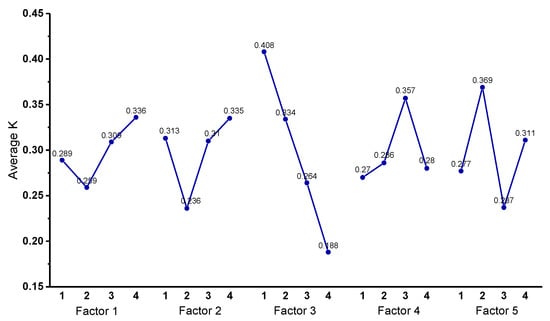
Figure 10.
Schematic diagram of the main relationship between geometric parameters and flow coefficient.
Similarly to the previous section, based on the factor range value R in the range analysis table, rank the five factors to obtain the importance of the influence of geometric structure parameters on the flow coefficient. The geometric parameters are ranked by their influence on the overall flow coefficient of the control valve and its connected flow path as follows: Factor 3 (valve body outer diameter), Factor 5 (bottom filet of the baffle), Factor 2 (valve inlet length), Factor 4 (outer diameter of the baffle), and Factor 1 (diameter of the throttle groove).
The flow characteristics of the regulating valve were analyzed with the aim of optimizing the maximum flow rate in the inner channel. It can be clearly observed that increasing the outer diameter of the valve body will reduce the flow area of the outer channel, significantly increase the inlet pressure, and reduce the overall flow capacity. Therefore, the main focus is on examining the impact of factors 1 and 2 with different values on the overall flow performance, while keeping other parameters constant, as shown in Figure 11. The other geometric parameters are as follows: valve body outer diameter 60 mm, baffle diameter 60 mm, and baffle filet radius 5 mm. The optimal selection of geometric parameters is as follows: throttle groove diameter 85 mm, and valve inlet length 17 mm. The worst design scheme is as follows: throttle groove diameter 55 mm, and valve inlet length 2 mm.

Figure 11.
Comparison of pressure contour maps for geometric parameter schemes aimed at obtaining the maximum flow coefficient: (a) best design scheme; (b) worst design scheme.
Table 5 shows the results of the numerical simulation comparison between the best and the worst geometric parameter schemes for the flow coefficient. If the inlet flow rate is 30 L/s and the outlet pressure is 0.1 MPa, the flow coefficient of the optimal solution is 0.4338 and the flow coefficient of the worst solution is 0.4234. From the pressure contour maps shown in Figure 11, it can be observed that the pressure drop generated by the optimal scheme at the pressure drop throttling section A–B in the throttling groove is significantly lower than that of the worst solution. When there is a larger-groove bottom diameter, the flow effect is better.

Table 5.
Comparison of the numerical calculation results for the geometric parameter schemes based on flow coefficient.
Figure 12 presents the curve of the pressure variation with distance in the flow field. At the inlet of the regulating valve spool, the reduced flow area leads to the formation of local high pressure, specifically referred to as pressure peak A. Due to the longer inlet length of the optimal valve, the pressure peak is closer to the flow inlet. When the fluid enters the outer channel, the throttling effect at the inlet of the outer channel causes an increase in flow velocity and a decrease in pressure, thus forming low-pressure point B. Subsequently, as the flow area increases, the flow velocity decreases and most of the static pressure is restored.
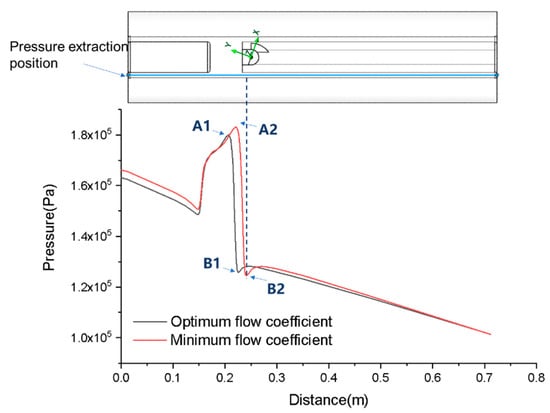
Figure 12.
Pressure variation along the axis direction under different geometric parameter schemes aimed at the maximum flow coefficient.
From the velocity contour maps in Figure 13, it can be observed that the worst performing scheme features a larger space in front of the valve, where a larger vortex is generated. The presence of this vortex increases the turbulence intensity of the entire flow field and also elevates the maximum pressure (as shown in Figure 10), resulting in greater pressure loss, which in turn reduces the flow coefficient of the regulating valve.
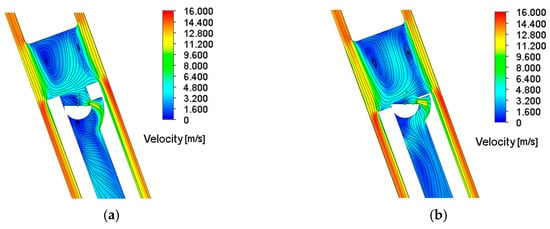
Figure 13.
Velocity contour map on the symmetry plane under different geometric parameter schemes aimed at the maximum flow coefficient: (a) best design scheme; (b) worst design scheme.
The outer diameter of the valve body is related to the flow area of the outer flow path, which has the greatest impact on the flow characteristics of the regulating valve. An increase in the outer diameter of the valve body will squeeze the size of the external flow channel. This will lead to a rise in the pressure in the front of the valve and an increase in the pressure difference across the valve spool and then increase the flow distribution size of the inner flow path, reducing the overall flow coefficient of the control valve that reduces the flow performance of the entire control valve. The outer diameter of the valve body is the most important geometric parameter. Expanding the diameter of the throttle groove can increase the internal flow rate and improve the overall flow capacity of the regulating valve, while the diameter of the throttle groove is the second most important geometric parameter.
For every 2° increase in inclination angle, there is a significant change in flow rate, as shown in Figure 14. On average, the flow rate increases by 0.052 L/s per degree. Due to the increase in the throttle valve port, the total flow area increases, and the pressure difference gradually decreases with the increase in the throttle valve port from 199 kPa to 180 kPa.
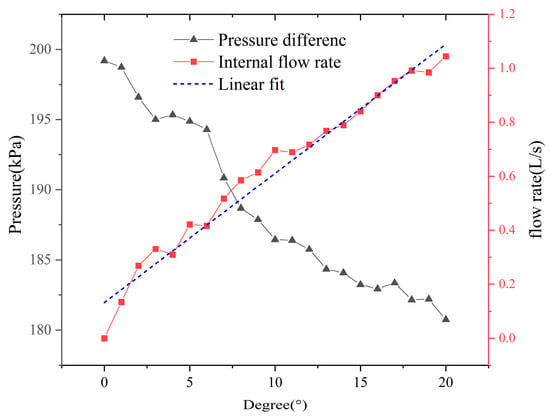
Figure 14.
Pressure differential and flow rate under different valve body inclination angles.
After the above analysis, the internal flow variation curve was fitted. Compared to the theoretical flow variation characteristic line, it can be found that when the maximum deviation point is 10°, the flow deviation value is 0.08637 L/s. Therefore, the minimum sensitivity of this design is 8.273%. It can be found through the curve that the maximum measurement error occurs at 4.75° and 19.05° (the flow values at these two points are higher than the flow at the previous point, causing the measurement error), and the maximum well deviation error is 0.95°. Therefore, the measurement accuracy of this structure is less than 1°.
4. Conclusions
Through numerical simulations and orthogonal experiments, the valve port design and flow characteristics of the gravity-driven flow control valve were investigated. Detailed analysis and optimization were conducted on the geometric parameters of the valve body. The results indicate that the gravity-driven flow control valve achieves the conversion between the valve body’s tilt angle and the flow signal by sensing the direction of gravity. Consequently, it exhibits high-precision, continuous, and stepless flow regulation capabilities in application scenarios such as mechanical inclinometers. Simultaneously, an effective mechanical-type well-inclination-sensing flow-control design method was established. The following conclusions can be obtained:
- (1)
- Numerical simulation analysis reveals the significant effect of the valve body tilt angle on the flow distribution characteristics of the shunt regulator valve. As the tilt angle of the valve body increases, the valve opening gradually enlarges, and the flow rate distributed in the internal flow channel increases approximately linearly, whereas the flow rate in the external flow channel decreases correspondingly. The influence of different fluid viscosities on flow characteristics was discussed. The effect is more pronounced when the fluid viscosity is below 0.05.
- (2)
- Through an orthogonal experimental design, it was found that increasing the diameter of the throttle groove and the inlet length of the valve, as well as reducing the outer diameter of the valve body, all contribute to increasing the flow rate in the internal channel and improving the overall flow coefficient. After optimization, the optimal solution was obtained, with an internal flow rate of 2.59 L/s, which is 149% higher than the original solution. The optimal structural scheme not only significantly increases the internal flow path flow rate, but also improves the overall flow capacity by optimizing the design of the throttle groove.
In future, the stability of the optimized gravity-driven valve in extreme underground environments will be verified, and the design principle of this project will be extended and applied.
Author Contributions
Conceptualization, Q.W. and L.L.; methodology, J.Q.; software, X.T.; validation, Q.W. and Q.X.; formal analysis, J.Z.; investigation, Y.L.; resources, X.L.; data curation, J.Y.; writing—original draft preparation, J.Q.; writing—review and editing, Q.X.; visualization, F.Z.; supervision, J.G.; project administration, G.J.; funding acquisition, Q.W. All authors have read and agreed to the published version of the manuscript.
Funding
This research was funded by PetroChina Key Core Technology Research Project, Research on key technology and equipment for drilling and completing 10,000 m ultra-deep oil and gas resource wells (2022ZG06).
Data Availability Statement
Data are contained within the article.
Conflicts of Interest
Authors Qing Wang, Li Liu, Jianhua Guo, Jiawei Zhang, Xiaoao Liu, Jinping Yu, Guodong Ji and Fei Zhou were employed by the company CNPC Engineering Technology R&D Company Limited. The remaining authors declare that the research was conducted in the absence of any commercial or financial relationships that could be construed as a potential conflict of interest.
Abbreviations
The following abbreviations are used in this manuscript:
| Ar | Minimum flow area between valve spool and valve body |
| ζ | Resistance coefficient |
| Δpr | Pressure loss |
| xi and xj | Coordinate component |
| ui and uj | Velocity components |
| v | Kinematic viscosity |
| vt | Vortex viscosity coefficient |
| ρ | Liquid density |
| P | Pressure |
| k | Turbulent pulsation kinetic energy |
| C | Flow coefficient of a control valve |
| qV | Fluid flow through the regulating valve |
| γ | Density of the fluid medium |
| Δp | Pressure loss generated by the regulating valve |
References
- Yang, C.; Han, L.; Bu, H.; Zhao, J. New Development and Future Direction of Modern Vertical Drilling Technology. Pet. Drill. Tech. 2007, 1, 16–19. [Google Scholar]
- Zhang, D.; Wu, M.; Lu, C.; Chen, L.; Cao, W.; Wang, Y. Tube-Based Adaptive Model Predictive Control for Deviation Correction in Vertical Drilling Process. IEEE Trans. Ind. Electron. 2022, 69, 9419–9428. [Google Scholar] [CrossRef]
- Matheus, J.; Ignova, M.; Hornblower, P. A Hybrid Approach to Closed-loop Directional Drilling Control using Rotary Steerable Systems. IFAC Proc. Vol. 2012, 45, 84–89. [Google Scholar] [CrossRef]
- Chai, L.; Zhang, K.; Yang, D.; Liu, B.; Zhang, D. Integral Modeling for Deviation Correction Trajectory of the Mechanical Vertical Drilling System. Machines 2021, 9, 161. [Google Scholar] [CrossRef]
- Cai, W.; Wang, P.; Zhu, Y.; Chen, G. Design scheme and key techniques for mechanical wireless inclinometer. Acta Pet. Sin. 2006, 2, 103–106. [Google Scholar]
- Li, L.; Xue, Q.; Liu, B.; Li, X.; Wang, J. Straightening Behavior Analysis and Research Progress of Mechanical Automatic Vertical Drilling Tools. J. Xi’an Shiyou Univ. (Nat. Sci. Ed.) 2018, 33, 90–97. [Google Scholar]
- Chen, Z. Self-Adjusting Mechanical Inclinometer While Drilling. China Patent CN86207607, 5 December 1987. [Google Scholar]
- Li, L.; Xue, Q.; Liu, B.; Zhao, L.; Li, X. A static mechanical automatic vertical drilling tool with double-layer positive pushing pistons for slim well drilling. J. China Univ. Pet. (Ed. Nat. Sci.) 2017, 41, 91–98. [Google Scholar]
- Li, L.; Xue, Q.; Liu, B.; Wang, J.; Li, X. Analysis and Optimal Design of Control Performance in Automatic Mechanical Vertical Drilling Tool. Bull. Geol. Sci. Technol. 2018, 37, 268–274. [Google Scholar]
- Wang, J. Research on Work Characteristics of the Eccentric Stable Platform in Mechanical Automatic Vertical Drilling Tool. Doctoral Thesis, China University of Geosciences, Beijing, China, 2020. [Google Scholar]
- Li, P.; Wang, L.; Liu, B. Angular position measurement method for the eccentric mechanism of the automatic vertical drilling tool. Drill. Eng. 2021, 48, 9–13. [Google Scholar]
- Mu, R. Research on the Simple Design of the Control System of Push-Back Rotary Steerable Tool. Master’s Thesis, Xi’an Shiyou University, Xi’an, China, 2023. [Google Scholar]
- Yin, C.; Bai, J.; Sun, C.; Li, Z.; He, J. Research and application of eccentric assembly. J. Northeast. Pet. Univ. 1999, 3, 58–60+144. [Google Scholar]
- Liu, Z. Application of concentric bias drill collar anti-skew technology in prone formation. Drill. Eng. 2007, 8, 13–14. [Google Scholar]
- Yang, X. Concentric Bias Weighted Drill Collar Deviation Control Effect in Strata Tend to Deflect. Coal Geol. China 2008, 20, 105+117. [Google Scholar]
- Feng, Q.; Dou, Z.; Zhang, Z.; Wang, Z. Study on the eccentric deflection controlling BHA and its application in Jiangsu. Oil Drill. Prod. Technol. 2002, 2, 4–7+82. [Google Scholar]
- Xia, H.; Wang, X.; Dai, J.; Ou, Y.; Tan, J. Establishment of force analysis model of bottom hole assembly for off-axis anti-deviation drill. Drill. Eng. 2004, 10, 39–42. [Google Scholar]
- Tian, H.; Chou, H.; Dong, G. Application of pre-bending pendulum drill tool anti-skew beating technology in Keping high and steep structure formation. West-China Explor. Eng. 2022, 34, 39–43. [Google Scholar]
- Zheng, J. Application of rapid drilling and anti-skew straightening technology of screw pendulum drill. Chem. Eng. Equip. 2019, 2, 58–59+49. [Google Scholar]
- Brackin, V.; Kronman, J.; Lanning, C. Activation of Downhole Mechanical Device with Inclination and/or Change in RPM. United States Patent Application US2023392471, 7 November 2023. [Google Scholar]
- Taylor, R.G., Jr. High or Low Fluid Flow Signalling Apparatus. United States Patent Application US3468035, 23 September 1969. [Google Scholar]
- Meng, Y.; Ren, Q.; Liu, F.; Gao, P.; Wu, X.; Zhao, Y.; Tang, X.; Wang, X.; Chen, J. The Utility Model Relates to a High Temperature and High Pressure Temperature and Inclinometer for Deep Well. China Patent CN110685672A, 14 January 2020. [Google Scholar]
- Liu, Y.; Cai, W.; Wang, P.; Liu, J.; Liu, T. Application of Power V and Mechanical Inclinometer in Heichi l Well. Pet. Drill. Tech. 2006, 1, 71–73. [Google Scholar]
- Liu, J.; Wang, L.; Deng, R.; Liu, M.; Li, X.; Li, P. Numerical Simulation Analysis on Internal Flow Field and Shutdown Characteristics of Anti-Recoil Valve. China Pet. Mach. 2023, 51, 85–91. [Google Scholar]
- Zhang, Z. Valve Design and Application; China Machine Press: Beijing, China, 2015; p. 251. [Google Scholar]
- Zou, Z.; Wang, F.; Wang, L. Study on unsteady flow field of butterfly valve in startup process of pressure-driven water diversion system in pumping station. J. Hydraul. Eng. 2018, 49, 678–686. [Google Scholar]
- Park, J.; Chung, M. Study on hydrodynamic torque of a butterfly valve. J. Fluids Eng.-Trans. ASME 2006, 128, 190–195. [Google Scholar] [CrossRef]
- Guan, Z.; Chen, T. Theory and Technology of Drilling Engineering; Petroleum Industry Press: Beijing, China, 2017; p. 349. [Google Scholar]
- Li, S.; Li, Z.; Zhou, A.; Wang, H. Optimization and test on throttle plate opening profile line of 3-waycontrol ball valve. J. Huazhong Univ. Sci. Technol. (Nat. Sci. Ed.) 2017, 45, 61–66. [Google Scholar]
- Qian, J.; Hou, C.; Mu, J.; Gao, Z.; Jin, Z. Valve core shapes analysis on flux through control valves in nuclear power plants. Nucl. Eng. Technol. 2020, 52, 2173–2182. [Google Scholar] [CrossRef]
- Qu, J.; Ji, G.; Wang, Q.; Wang, J.; Wang, C.; Hu, Y.; Li, Y.; Xue, Q. Analysis of the dynamic characteristics of an eccentric cylinder in axial flow. Geoenergy Sci. Eng. 2024, 236, 212735. [Google Scholar] [CrossRef]
- Qu, J.; Xue, Q.; Wang, J.; Sun, J.; Li, J. Optimization of a Turbine Flow Well Logging Tool Based on the Response Surface Method. Machines 2023, 11, 455. [Google Scholar] [CrossRef]
- Liu, R.; Zhang, Y.; Wen, C.; Tang, J. Study on the design and analysis methods of orthogonal experiment. Exp. Technol. Manag. 2010, 27, 52–55. [Google Scholar]
- Gao, Z.; Yue, Y.; Li, J.; Wu, H.; Jin, Z. Effects of the valve body and the valve seat of regulating valves on thevalve flow characteristics. Fluid Mach. 2021, 49, 43–49. [Google Scholar]
- Wang, C.; Ma, D.; He, T.; Zhou, D.; Hao, F. Analysis Based on Orthogonal Experiment of Lubrication Performance of Micro-exturing Valve Core on Coal Mine Water Hydraulic Relief Valve. Chin. Hydraul. Pneum. 2017, 9, 1–6. [Google Scholar]
Disclaimer/Publisher’s Note: The statements, opinions and data contained in all publications are solely those of the individual author(s) and contributor(s) and not of MDPI and/or the editor(s). MDPI and/or the editor(s) disclaim responsibility for any injury to people or property resulting from any ideas, methods, instructions or products referred to in the content. |
© 2025 by the authors. Licensee MDPI, Basel, Switzerland. This article is an open access article distributed under the terms and conditions of the Creative Commons Attribution (CC BY) license (https://creativecommons.org/licenses/by/4.0/).